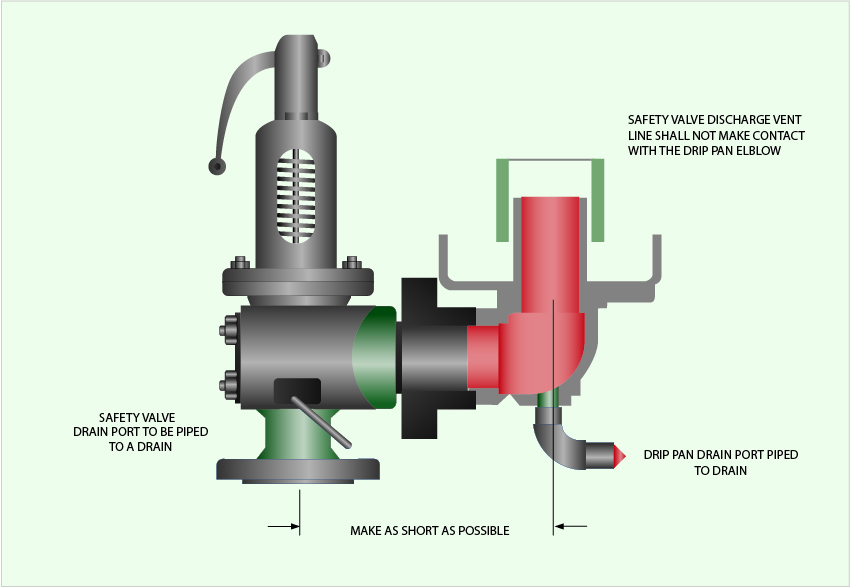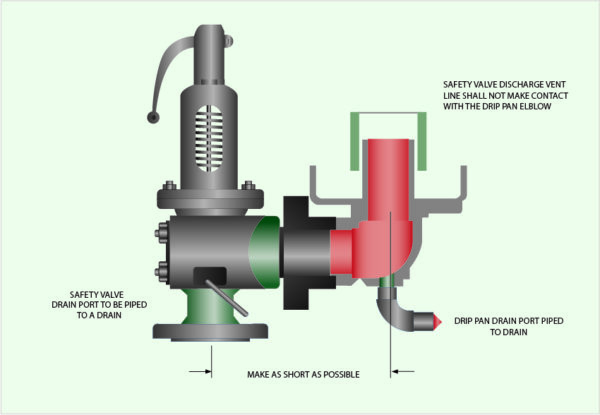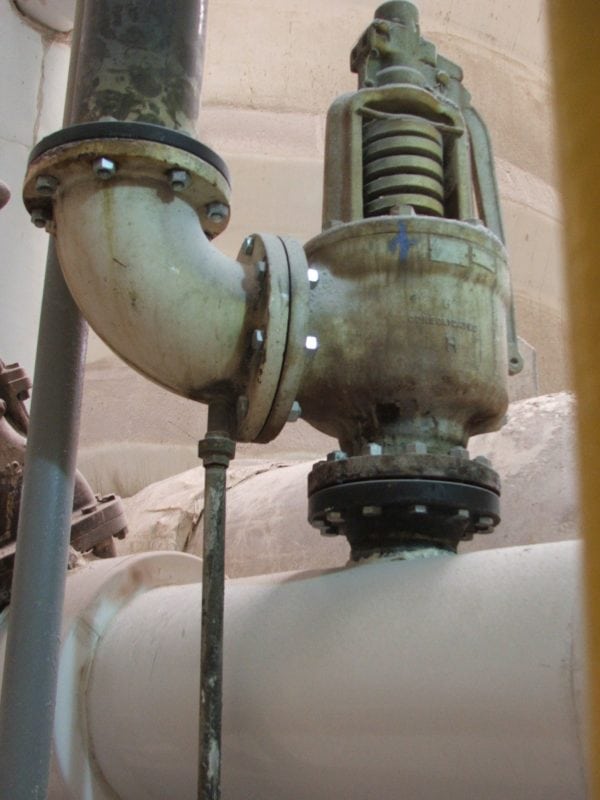Steam Safety Valve, Proper Sizing and Installation – Best Practice No. 15

Do you want this article in PDF format? Download it here:
Download a PDFBEST PRACTICE NO. 15
1. PROPERLY SIZE AND INSTALLATION OF STEAM SAFETY VALVES
1.1 INTRODUCTION TO SAFETY VALVES
One of the most critical safety devices in a steam system is the safety valve. Safety valves protect personnel, equipment, and property from potentially dangerous high temperatures and forces caused by excessive steam pressure in the steam system.
Steam safety valves are required by codes, insurance, and corporate mandates. Therefore, it is important to have the safety valve properly sized and installed to meet all code requirements. A well-documented database and up-to-date records of all safety valves in the steam system is a standard for today’s plant operation.
Figure 1: Steam Line Safety Valve
The steam safety valve database containing all relevant information about all safety devices that it can use for yearly inspection of the Section I and Section VIII (code) safety valves. The safety valve database should always be updated with the yearly information from inspections and changes based on plant standards; insurance company recommendations; and federal, state, or local government requirements.
The code that establishes the requirements for steam safety valves is written by the American Society of Mechanical Engineers (ASME). ASME, through its committees, has published and continues to update the Boiler and Pressure Vessel codes for safety valves. It is the responsibility of plant personnel—primarily the plant’s steam team—to know which codes apply to the different parts of the steam system.
2. SIZING GUIDELINES FOR SAFETY VALVES
- The set point for the safety valve shall be at least 10% between the operating system pressure and the safety valve set pressure. This will prevent the safety valve from operating in the simmer mode, which the code does not allow.
- When considering a safety valve downstream of a steam pressure control valve, the total capacity of the safety valve at the set point must exceed the steam control valve’s maximum flow capacity (the largest orifice available from that manufacturer) if the steam valve were to fail in the fully open position.
Figure 2: Steam Safety Valve on a Steam line
- The plant should size the safety capacity according to the control valve’s maximum flow by calculating the inlet steam pressure (PI) at the maximum steam pressure, which is the safety valve setting of the steam supply source. The plant should not calculate the maximum steam pressure using the steam system’s nominal operating pressure.
- Many times, it is not possible to install a single safety valve because of high steam capacity or physical limitations. An acceptable alternative is to employ multiple safety valves on the same steam system. The safety valves can be of different set points so long as the set points are below the steam system maximum design pressure. The total steam capacities must be equal to or greater than the maximum steam flow to the system to ensure they never exceed the maximum steam pressure.
Figure No. 3: Two Stage Pressure Reducing Valve Station with Safety Valve
- When a safety valve is installed downstream of a control valve or a regulating valve and a bypass valve is installed, the bypass valve must always have a smaller diameter than the control valve to ensure it has a lower flow coefficient (Cv) than the control valve. If the bypass is the same size as the control valve, then the safety valve has to be sized for the valve (control valve or bypass) with the higher Cv.
- The plant should set the set pressure of the safety valve at or below the maximum allowable working pressure (MAWP) of the component with the lowest MAWP in the steam system. This includes, but is not limited to, steam boilers, pressure vessels, equipment, and piping systems. In other words, if two components on the same system are rated at different pressures, the safety device protecting the steam system for both devices must be set at the lower of the two MAWPs.
3. INSTALLATION GUIDELINES FOR SAFETY VALVES
- The steam system must be clean and free of any dirt or sediment before commissioning the steam system with a safety valve. This can be accomplished by preparing the steam piping before the steam piping has been installed or by conducting controlled steam blows after the installation.
- The safety valve shall be connected to the steam line independent of any other type of connection. Also, the safety valve should be located as close as possible to the steam line or vessel.
Figure 4: Typical Safety Valve Installation
- Safety valve flanges will be installed according to the appropriate bolt torque specifications, procedures, and torque patterns.
- The safety valve must be installed at least 10 pipe diameters downstream of any valve, elbow, or other device that could disrupt the steam flow.
Figure 5: Safety Valve Installation After Pressure Reducing Valve
- The safety valve must be mounted vertically, with the valve’s spindle in an upright vertical position. The safety valve shall not be more than 1 degree off vertical.
- The steam line or pressure vessel shall be free of any vibration or water hammer that could change the set pressure of the safety valve.
- The inlet steam piping to the safety valve must be equal to or larger than the safety valve inlet connection. For a safety valve with a 3” inlet connection, the piping from the vessel or header shall be 3” or larger.
- There shall be no intervening shutoff valves between the safety valve inlet and the steam component that could permit the safety valve to be isolated from the system or that would restrict the steam flow to the safety valve.
- Drains or vent openings on the body of the safety valve shall not be plugged or capped. The purpose of the drain or vent openings is to allow any liquid that might accumulate above the discharge valve to drain. The drain or vent connection shall be piped to a drain for proper evacuation.
- Safety valves are set, sealed, and certified by the manufacturers or an authorized and certified assembler to prevent tampering by unauthorized personnel. If the wire seal on the safety valve is not intact, the valve is no longer in compliance with the code and should be replaced as soon as possible.
- For multiple safety valve installations using a single connection, the internal cross-sectional area of the inlet shall be equal to the combined inlet areas of all the safety valves.
Figure 6: Safety Valve Installation on Heat Transfer
- When using more than one safety valve, the discharge vent piping must be sized to accommodate the full flow of all safety valves in a fully open position simultaneously when there is no backpressure on the safety valve outlets.
- Never attach the safety valve discharge vent piping directly to the safety valve, which would place undue stress and weight on the safety valve body and change the set pressure of the safety valve. A very short section of vent pipe must be used to connect the safety valve drip pan elbow to the safety valve if the drip pan elbow is not directly connected to the safety valve.
- All safety valves should use a purchased or custom-made drip pan elbow on the safety valve outlet for the following reasons:
- The drip pan elbow isolates the safety valve from the weight of the safety valve vent piping.
- The drip pan elbow changes the steam flow at the outlet of the safety valve from horizontal to vertical.
- The safety valve discharge vent pipe may not touch the drip pan elbow. The discharge vent piping should be supported independently from the safety valve/drip pan elbow assembly to prevent undue stresses on the safety valve.
- The drains on the drip pan elbows are designed to collect any condensed liquid and rain and allow flow safely away from the safety valve. Do not plug the drip pan elbow openings.
- Steam will not escape from the drip pan elbow configuration if the safety valve discharge vent line is properly sized.
3.1 Safety Valve Discharge Vent Piping
- The diameter of the discharge vent pipe must be equal to or greater than the safety valve outlet.
- The discharge vent line will be sized so that no backpressure is created on the safety valve discharge during the discharge mode.
- Minimize the length of the discharge vent pipe. A rule of thumb is that if the discharge vent pipe exceeds 30 feet and has more than one elbow, then the discharge vent piping must be increased in size to prevent backpressure on the safety valve.
- The discharge outlet of the vent pipe should be piped to the closest location where free discharge of the safety device will not pose any safety hazard to personnel. The typical safety valve discharge point is above the roofline or above the plant’s operating unit. The safety valve discharge vent should be no less than 7 feet above the roofline or the operating unit. The top of the discharge vent line should be cut at a 45-degree angle to dissipate the steam discharge thrust, to prevent capping of the pipe, and to visually signify to plant personnel that it is a safety valve vent line.
The proper selection, installation, and use of safety valves require a complete understanding of the ASME code and any additional requirements adopted by insurance companies or the local jurisdictional authority.
Figure No. 6: Is an incorrect installation with the discharge vent line is firmly attached to the safety valve outlet which will put stress on the safety valve.
Figure 7: Discharge Vent Line Attached to the Safety Valve – Installation is Wrong.
4. BEST PRACTICE ROADMAP
- Establish plant standards for safety valve installation and selections per the Steam Best Practices.
- Add all safety valves to a database.
- Review all safety valves periodically, depending on plant standards; insurance company recommendations; and federal, state, or local government requirements.

















